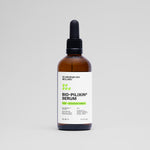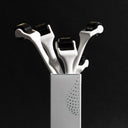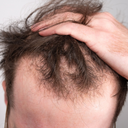Hair regrowth takes time, and it’s not always easy to tell if your efforts are paying off. That’s where hair growth progress tracking comes in.
By using simple methods like photos, measurements, and scalp checks, you can see real progress over time—even when it feels like nothing is changing.
This guide breaks down the best ways to track your hair journey, so you know what’s working and what’s not.
Table of content
Why track hair growth?
Tracking your hair growth helps you see real results and avoid second-guessing your progress. Hair grows slowly—about half an inch per month—so small changes are easy to miss without a system in place.
Taking photos, measuring length, and checking scalp coverage can help you notice regrowth, spot shedding patterns, and stay motivated. It’s also a great way to figure out if a treatment like Minoxidil, Finasteride, or a hair transplant is working for you.
If you don’t track, you might give up on a routine too soon or miss signs that your hair needs extra care. A little patience and a simple tracking method can make a big difference in staying on the right path.
As your leading source for hair health information over the past 4 years, we never compromise on accuracy. When it comes to your health, you deserve information you can truly rely on - and earning your trust is our top priority.
Here's how Scandinavian Biolabs ensures every piece of content meets the highest standards of accuracy and integrity:
- Credentialed Experts: Our reviewers are actively practicing doctors and medical researchers
- Stringent Reviews: Content undergoes rigorous editing by subject specialists and review by a practicing doctor.
- Evidence-Based: We rely on well-established research from trusted scientific sources like peer-reviewed journals and health authorities.
- Full Transparency: Our editorial standards, writer credentials, reviewer credentials, correction process, and funding are all publicly documented.
- Independent Voice: While we do promote products, we operate in a vacuum to business operations. Our main goal is just an unwavering commitment to providing medically-sound guidance.
You can count on Scandinavian Biolabs to consistently deliver the trustworthy health information you deserve. Read our Editorial Standards.
How hair grows: Understanding the growth cycle

Hair doesn’t grow overnight—it follows a cycle. Knowing these stages can help you understand what’s normal and what’s not.
- Anagen (growth phase): The active growing stage, lasting 2 to 7 years. The longer this phase, the longer your hair can grow.
- Catagen (transition phase): A short 10-day phase where hair stops growing and prepares to shed.
- Telogen (resting phase): Hair stays in place for 2 to 4 months before falling out.
- Exogen (shedding phase): Old hairs shed so new ones can grow. Losing 50-100 hairs per day is normal.
Every strand is in a different stage, so shedding a little every day is part of the process.
Best methods to track hair growth progress
Here are some of the best ways to track hair growth over time:
- Take monthly photos from the same angles.
- Measure hair length using a ruler or tape.
- Check scalp coverage for density changes.
- Monitor shedding patterns over time.
- Use hair growth tracking apps for easy comparisons.
Each method helps you see real progress, even when changes seem slow. Let’s break them down in more detail.
1. Photos
Taking regular photos is one of the easiest and most effective ways to track progress. Our eyes play tricks on us, and changes happen too slowly to notice day by day. A good set of photos lets you compare months of growth side by side.
How to do it:
- Take pictures once a month—not daily, or you won’t see differences.
- Use consistent lighting and a plain background.
- Capture front, sides, crown, and back for a full view.
- Keep your hair dry and styled the same way each time.
- Use a tripod or ask someone to take the photos for better consistency.
2. Measuring hair length
Sometimes, growth isn’t visible just by looking. Measuring gives a clear idea of how much hair has actually grown.
How to do it:
- Use a soft measuring tape or ruler.
- Pick a fixed reference point (e.g., forehead to hairline, nape to ends).
- Measure hair when it’s dry and straight for accuracy.
- Track measurements every 4-6 weeks to see steady progress.
3. Checking scalp coverage
Hair density changes before length does. A thinning area filling in with new growth is a good sign, even if the hair is short.
How to do it:
- Part your hair the same way each time and compare photos.
- Look for new baby hairs along the hairline or thinning areas.
- Check under bright light or with a hand mirror for better visibility.
4. Monitoring shedding patterns
Shedding too much? Noticing clumps of hair in the shower? Tracking shedding can help you understand whether hair loss is normal or a sign of a deeper issue.
How to do it:
- Count how much hair you lose daily or weekly (normal = 50-100 hairs/day).
- Pay attention to seasonal changes—some people shed more in fall and spring.
- Note changes after starting a treatment—Minoxidil can cause temporary shedding before regrowth begins.
5. Using hair growth tracking apps
If you like keeping things digital, apps can simplify tracking with reminders, photo overlays, and growth logs.
How to do it:
- Download a hair tracking app like Hair Journal, Miiskin, or HairCam.
- Set reminders to take progress photos.
- Use the photo overlay tool to compare changes over time.
- Log details like shedding, treatments, and hair care habits.
Hair growth timelines for different treatments

Hair regrowth doesn’t happen overnight. Every treatment works on its own timeline, and patience is key. Some methods show early signs of improvement, while others take months before changes become noticeable.
Minoxidil
Minoxidil is one of the most well-known topical treatments for hair regrowth. It works by increasing blood flow to hair follicles, encouraging the growth phase to last longer.
Results don’t happen right away. In fact, shedding often increases in the first few weeks as weaker hairs fall out to make way for new ones.
By the three-month mark, new hair may start to appear, but the most noticeable changes happen between six and twelve months.
Consistency is the secret—stopping treatment can reverse progress.
Finasteride
Finasteride works by blocking DHT, the hormone responsible for male pattern baldness. Unlike Minoxidil, which stimulates growth directly, Finasteride helps prevent further hair loss while allowing existing hair to thicken.
Most people don’t see a difference until four to six months in, and the best results often take a year or more.
Since it’s a long-term commitment, tracking progress helps determine if it’s worth continuing.
Hair transplants
A hair transplant permanently moves healthy follicles to thinning areas. It’s a popular option for those who want a lasting solution.
The first few weeks can be misleading—transplanted hairs often fall out before regrowth begins.
New hair typically starts appearing at three to four months, with major improvements around the six-month mark.
By twelve months, the final results become clear, with continued thickening into the second year.
PRP therapy
Platelet-rich plasma (PRP) injections use growth factors from your own blood to stimulate hair follicles.
While some people notice early improvements after one or two sessions, the real progress happens after three to six months of consistent treatments.
Many clinics recommend a maintenance plan to keep results going long-term.
Natural methods (diet, scalp massage, oils)
Lifestyle changes like improving nutrition, massaging the scalp, and using essential oils can support hair health.
Since these approaches work gradually, noticeable changes usually take three to six months. They don’t always lead to dramatic regrowth but can improve hair thickness and reduce shedding over time.
What factors affect the hair growth tracking?
Hair growth progress isn’t the same for everyone. Several things can speed it up or slow it down:
- Genetics – Some people naturally grow hair faster than others.
- Age – Growth slows down as we get older.
- Hormones – Conditions like thyroid imbalances or PCOS can affect hair regrowth.
- Diet and nutrition – Nutrients like iron, biotin, and protein play a big role.
- Stress levels – High stress can lead to temporary hair loss (telogen effluvium).
- Scalp health – A clean, well-moisturized scalp helps hair grow better.
- Hair care habits – Heat styling, harsh chemicals, and tight hairstyles can cause breakage.
- Consistency – Skipping treatments or changing routines too often can slow progress.
Common mistakes in hair growth tracking (and how to avoid them)
Tracking progress helps keep you motivated, but certain mistakes can make it harder to see real results. Here are some common missteps and how to fix them.
Checking progress too often
It’s tempting to inspect your hair every day, but growth is slow. Looking too frequently makes changes harder to notice, leading to frustration.
Instead, take photos once a month under the same lighting and angles. This way, you’ll have clear comparisons without the daily guesswork.
Using inconsistent tracking methods
One month, you measure length. The next, you check scalp density. Without a consistent method, tracking results becomes unreliable.
Pick a primary method (photos, measurements, or parting tests) and stick with it. This keeps progress clear and measurable.
Ignoring shedding phases
Many treatments, especially Minoxidil, can cause shedding at first. Some people panic and quit, assuming it’s making things worse.
Shedding is often a sign that the treatment is working. If you’re losing hair but also seeing new growth, stick with it—most shedding phases last only a few weeks.
Expecting overnight results
Hair regrowth takes time. If you’re expecting instant changes, it’s easy to feel discouraged.
Instead, set realistic expectations. Most treatments take at least three to six months before noticeable progress happens. Patience pays off!
A holistic approach to your overall hair health

Tracking hair growth is important, but supporting your hair with the right care matters just as much. A strong routine can make a big difference in maintaining healthy, thriving hair.
One option some people explore is Bio-Pilixin Activation Serum. While no product can guarantee results, this serum is designed to support hair health with plant-based ingredients and clinical research behind it.
Developed with plant growth factors and tested in a clinical trial, Bio-Pilixin showed promising results in reducing hair loss and improving hair density.
In a study with 30 participants, 77% noticed reduced shedding within 45 days, and 93% saw a reduction in hair loss after 150 days.
Key ingredients that support hair health
- Capilia Longa® – A plant-based compound that has shown up to 89% reduction in hair loss in individual studies.
- Niacinamide – Helps strengthen hair by supporting keratin production.
- Vanillyl Butyl Ether – A mild warming agent that may help improve blood flow to the scalp.
Bio-Pilixin is formulated with vegan-friendly ingredients and has been evaluated by third-party labs for quality. Many users say they first notice less hair in the shower after a few weeks.
Results vary, and hair growth depends on multiple factors, but if you're looking for something to support your routine, Bio-Pilixin could be worth considering.
Conclusion
Tracking your hair growth is a game-changer when it comes to staying motivated and seeing real progress. Since hair grows slowly, it’s easy to miss small improvements—but with the right tracking methods, you can actually see the difference over time.
Taking monthly photos, measuring length, and checking scalp coverage are some of the easiest and most effective ways to track progress.
If you’re using a treatment like Minoxidil, Finasteride, or PRP therapy, patience is key.
Most treatments take at least three to six months to show results, and sticking with your routine is what really makes the difference.
Hair growth isn’t just about tracking—it’s also about keeping your scalp healthy, using the right products, and taking care of your overall well-being.
Whether you’re using medical treatments, natural remedies, or lifestyle changes, consistency is what matters most. Stay patient, keep an eye on your progress, and trust the process.
FAQs
How often should I track my hair growth progress?
Once a month is best. Checking too often makes it hard to notice real changes. Photos, measurements, and scalp checks work best when done consistently over time.
Why does my hair look thinner after starting Minoxidil?
This is called "shedding," and it’s actually a good sign. Minoxidil speeds up the hair cycle, pushing out weaker hairs to make room for stronger ones. Shedding usually stops within a few weeks, and new growth follows.
Can stress really affect hair growth?
Yes. High stress levels can push hair into the shedding phase, leading to noticeable thinning. Managing stress through sleep, exercise, and relaxation techniques can help support hair health.
How do I know if a hair growth treatment is working?
Look for less shedding, baby hairs appearing, and thicker coverage over time. Treatments like Minoxidil and Finasteride take months to show results, so patience is key.
What’s the best way to measure hair length accurately?
Use a soft measuring tape and pick a fixed reference point—like from the forehead to the hairline or from the nape to the longest strand. Measure when hair is dry and straight for the most consistent results.
Is it normal for hair growth to slow down with age?
Yes, hair naturally grows slower as we age, and the hair cycle shortens. Eating nutrient-rich foods, keeping the scalp healthy, and using hair-friendly products can help maintain growth as you get older.
References:






